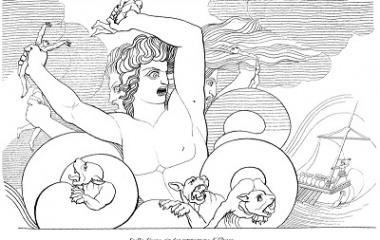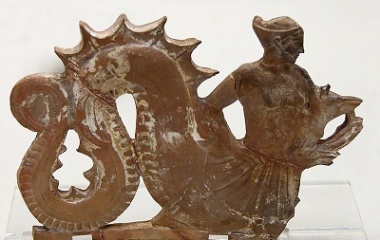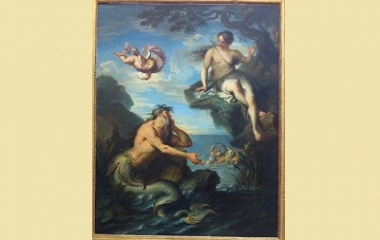Although she began her life as a ravishing nymph, Scylla is remembered as a sea monster who terrorized the ancient Greeks as they passed through a narrow ocean strait. She gobbled up countless sailors and drove many ships to a watery grave.
Characteristics
Physical Description
At the beginning of her life, Scylla lived among the sea nymphs who wrought havoc on the hearts of young Greek men. She had milky skin, hair like silk, and a sweet face that could make a man fall in love with her in an instant.
Syclla’s beauty doomed her to become an object of jealousy. Black magic was used to transform the maiden into a monster. She kept her torso and he sweet face, but her delicate legs were deformed into a nest of snarling dogs, and she sprouted a long, thick tail with scales and spikes like a dragon. Some myths describe her with twelve tentacles and six grisly heads, connected to her body by serpentine necks.
Special Abilities
Scylla is known for her endless greed and her ferocious strength. In The Odyssey, the goddess Circe warns Odysseus that
“No seaman ever, in any vessel, has boasted of sailed through the strait unharmed, for with every single head of hers she snatches and carries off a man from the dark-prowed ship.”
The sound of her voice, like a hundred yapping dogs or braying hounds, can make the bravest sailors tremble with fear, and the sight of her can traumatize a man for life.
Related Creatures
Three possible goddesses are put forward as the mother of Scylla. In The Odyssey, the mother of the monster is an obscure sea goddess named Crataeis. Later, scholars proposed that Crataeis was another name for Ceto, a primordial sea goddess, or Hecate, the triple-bodied goddess of magic and passageways. A fourth possible candidate is Lamia, a monstrous shapeshifter who is famous for her man-eating habits in her own right.
Her father has been identified as Phorcys, a primordial sea god, or an obscure character named Titon.
Her reign of terror is supported by another monster, who lives on the other side of her deadly strait. While she hides in a cave in the cliffs, using her long necks to swoop down and pluck sailors from their ships, Charybdis lurks in the waters below. Charybdis has been described as a giant whirlpool, so powerful that he creates a roar loud enough to drown out Scylla’s yelping. Trying to dodge Charybdis, ships are forced to hug the cliff’s edge and sacrifice six of their best men to Scylla’s hungry heads. As Circe says in The Odyssey,
“far better to lose six men and keep your ship than to lose your men one and all.”
Cultural Representation
Origin
Scylla appears in some of Greek’s most ancient texts, including Homer’s Odyssey of the 8th century BC and Ovid’s Metamorphoses of the 1st century AD. She was discussed by Virgil, Seneca, Pliny the Elder, and Plato each in turn. Five-hundred-year-old vases and urns, painted with her image, have been found in archaeological digs of Greek towns.
Famous Myths
The beginning of Scylla’s misfortunes is explained in a myth about her transformation. Scylla was once a beautiful, innocent creature, beloved by all the sea nymphs. She loved to bathe in the pools by the sea side, combing her long hair with the nymphs’ combs and prattling to them about the men whom she had evaded. The nymphs, who had their own fair share of unwanted attention from men, tried to warn Scylla that people could become aggressive when they were in love, but the young maiden remained lighthearted and careless. She sunned herself on the beaches without any clothes and luxuriated in the tide pools.
One day, a sea god name Glaucus caught sight of the beautiful nymphette. He was captivated, but when he tried to approach her, she fled on her dainty feet. Grumpy Graucus then complained about his rejection to Circe, a sea witch and a master brewer of potions. Little did Glaucus know that Circe cherished a secret infatuation for him, and when she heard about his desire for Scylla, she was enraged. She snuck to one of the nymphette’s favorite pools and poisoned it with a terrible potion. When the poor maiden returned to bathe, her beautiful legs were twisted into yapping dogs, and she felt a burning pain as six monstrous heads sprouted from her back. When Glaucus saw her again, he was horrified and heartbroken. He abandoned Scylla to her fate and cursed Circe for her jealous rage.
After her transformation, Scylla hid herself in the cliffs that overlooked her old bathing pool. She took out her rage against men—whose unwanted passion she blamed for her fate—by attacking their ships whenever they sailed by, but her greatest opportunity for revenge came when Odysseus and his crew passed her.
Spurned by Glaucus, Circe had fallen in love with a new, clever, and dashing man: Odysseus. For some time, she had kept him and his crew imprisoned on her island, but when she saw how he longed to return home, she released him and even gave him advice about how to make his voyage safely. She warned him about the dangers of Scylla and Charybdis, telling him to remain hidden below deck, un-armed, when he passed the sea monster’s cave.
Doubtless, Scylla would have been delighted to devour Odysseus, Circe’s lover. Unfortunately, he hid below deck as Circe had instructed him, and she had to be satisfied with eating his six strongest and sturdiest crew members.
After she attacked other important voyagers (most notably the Argonauts), the gods grew tired of Scylla’s bloodbath. They decided to add her to “the twelve labors of Heracles.” Incredibly, the hero managed to slay her by cutting off each of her heads, one by one. For a while, she served as one of the guardians of the underworld. Then, she was resurrected by her father. Finally, Poseidon took pity on the sweet-faced monster and transformed her into a giant rock, thereby ending the miserable cycle of bitterness and revenge that her life had become.










